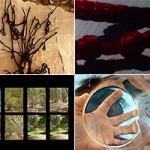EVEN GRAY FEELS BLUE; Negin Sharifzadeh; TRT: 8.18
Individual memory: Collective memory – not separated, rather there is an interaction of the two. The echoes of the individual move into collective realities. Sorrow becomes social malaise.
 Tell us about “Shabaneh,” the poem you used by Ahmad Shamlou.
Tell us about “Shabaneh,” the poem you used by Ahmad Shamlou.
Ahmad Shamlou was one of the most important contemporary Iranian poets. Shabaneh is the name of several of his poems that has been included in his different poetry books such as Abraham in Fire. The poem which I have brought to the visual language of animation is also from the same book.
Shabaneh translates as at night, or during the night. These poems, then, though found in different books, form a group of sorts, playing with this metaphor of night. Of both longing and the wait for hope, light, the rising of the sun and morning. He depicts this longing for a new day, a better day to come in both sociopolitical and personal contexts. He also opens our eyes to the beauty of night itself, as one of his poems suggests his wait for true love and how pleasant the wait is. It talks about peoples’ resistance in times of upheaval, wars and desperation. In Abraham in Fire, Shamlou talks about a friend metaphorically who was executed in the aftermath of a political struggle, in relation to the struggles of the Biblical Abraham.
You have said “The echoes of the individual move into collective realities, Sorrow becomes social malaise.”- can you say more about this as it connects the personal to the collective – meaning that “art could transform the world?”
I was referring to memory and how it functions. The individual memory is not necessarily separate from the collective memory. It is in the interaction of the two that each finds its own meaning. In the case of a social event you have your own personal memory versus the memory experienced by the mass of people. Yet the collective memory has no meaning without the constituent molecules made of the individual. In times of extreme crisis, these molecules somehow come together, and form into something larger and coherent. These are times of change. But Shamlou also dealt with those other times, when the molecules are scattered and find nothing to attach to.
What is the place of art and/or filmmaking in the world?
This is a very general question. The way I see it, art generates culture, and culture brings forth new social behaviors, diverse perspectives and change, hopefully for better! The sharing of different perspectives is itself a form of change, since it changes the way the viewer sees the world.
Film is a way of storytelling. Since human’s existence on this planet, storytelling has been one of the very first and most powerful mediums since our hunting and gathering days, for educating our kids, building cultural values, political assembly, you name it! I think we can find the roots of language itself in our urge to tell stories.
 What as your creative process with this film? How do you approach translating emotions into their aesthetic essences?
What as your creative process with this film? How do you approach translating emotions into their aesthetic essences?
I always create a mood with my visual language, which lends itself to a certain feeling. As the story goes by, these moving images become like a chain of ambiences in which the audience is immersed, and their subconscious engaged. I feel not only my audience grasps the feeling of the moment in the film, but also they tap into their own individual memories, so it creates an emotional resonance within them. So parallel to my story, the story in the film, they are also experiencing their own stories.
My main technique is stop-motion animation, so I am creating 12 compositions a second then editing all these images together in the computer. This extended process is intimately linked, for me, to the impact of the films. My emotions during the creation of the film has as much impact on the final work as the emotions triggered by the story that is being told.
On Even Gray Feels Blue, I had the wonderful experience of collaborating with the amazing musician and composer, Negar Bouban, whose music serves as the spine for the film. We worked through Skype, as she was in Tehran most of the time I was making the film. She had come up with the composition of the song based on the lyrics of the poem, and I used the same lyrics to create the visual language. So my animation was made very much in dialogue with her music, rather than the music serving as a score to the animation. As if our mediums of expressions were communicating through the lyrics of the poem we had in common!





